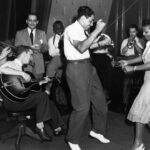The phenomenon known as Dancing Mania, or choreomania, first emerged in 14th-century Europe following the Black Death, persisting for centuries across central Europe, particularly in regions encompassing modern-day Germany, the Netherlands, and Belgium. While outbreaks gradually subsided by the early 17th century, the episodes left a lasting mark on historical and medical understanding. The term “dancing mania” itself stems from “choreomania,” a combination of the Greek words “choros” (dance) and “mania” (madness), aptly capturing the perceived nature of this strange affliction. A notable variant, tarantism, manifested primarily in southern Italy from the 15th through the 17th centuries, initially attributed to the venomous bite of the tarantula spider.
Individuals affected by dancing mania engaged in continuous, often prolonged, and erratic dancing. This wasn’t a joyful celebration; it was frequently frenzied, and sometimes even erotic, in nature. Historical accounts reveal that in the 14th century, the dancing mania was initially associated with a corrupted form of St. John’s Day festivities, intertwined with ancient pagan customs. However, by the 16th century, a shift in interpretation occurred. The outbreaks were commonly perceived as divine trials, either sent by a saint or as punishment from God for collective sins.
During the peak outbreaks of the 14th and 15th centuries, the dancing mania was largely considered a matter for religious and civic authorities, namely magistrates and priests, rather than medical practitioners. This perspective arose because the condition proved resistant to legal decrees and religious exorcisms, highlighting the perplexing nature of the affliction. It seemed to defy conventional understanding and remedies of the time.
The 16th century witnessed a pivotal change in the understanding of dancing mania, largely influenced by the physician Paracelsus. He challenged the prevailing belief that saints were directly causing or intervening in the cure of dancing mania. Instead, Paracelsus proposed a psychogenic or even malingered etiology, suggesting the origins were rooted in psychological factors or deliberate feigning. This reclassification effectively brought dancing mania into the domain of physicians, marking a significant step toward medicalizing the phenomenon.
Paracelsus explored various treatment approaches, ranging from mystical and psychological interventions to pharmacological remedies, tailoring his methods based on his assessment of the presumed causes in individual patients. In contrast to the varied approaches for choreomania, only music was reported to provide any tangible relief for those suffering from tarantism, further highlighting the nuanced differences between the two forms of dancing mania.
Later scholars and researchers have proposed a range of theories to explain dancing mania. These include the idea of mass stress-induced psychosis, suggesting it was a mass psychogenic illness triggered by immense societal pressures and anxieties. Other interpretations point to it being a culturally determined form of ritualized behavior, a manifestation of religious ecstasy taken to an extreme, or even a consequence of food poisoning caused by ergot fungi. Ergot, a fungus that grows on rye and other grains, produces toxic and psychoactive chemicals that could potentially induce such erratic behaviors.
In conclusion, it’s crucial to recognize that dancing manias likely didn’t stem from a single, unified cause. Instead, the historical episodes were probably a complex interplay of component factors. These likely included genuine psychogenic illness driven by widespread stress and anxiety, instances of malingering or intentional mimicry, and the influence of deeply ingrained ritualized behaviors within the affected communities. The mystery of dancing mania continues to fascinate, serving as a potent reminder of the intricate relationship between psychological, social, and potentially biological factors in shaping collective human behavior throughout history.

